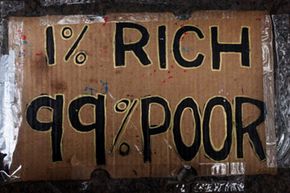 “Occupy Wall Street protests on behalf of the "99 percent." See more protesting pictures.Mario Tama/Getty Images
“Occupy Wall Street protests on behalf of the "99 percent." See more protesting pictures.Mario Tama/Getty Images
Officially, the Occupy Wall Street movement began on Sept. 17, 2011 in the streets of Lower Manhattan’s Financial District. But Egyptians who flooded Cairo’s Tahrir Square, demanding the ouster of the dictatorial President Hosni Mubarak, provoked interest in a U.S. public uprising months earlier. On Feb. 2, 2011, while Mubarak clung to his final shreds of power, Adbusters staff writer Kono Matsu wrote an editorial blog post on the Web site of the Canadian anti-consumerist magazine, urging Americans to take a cue from Cairo [source: Weigel and Hepler]. Frustrated with the arguably toothless governmental response to financial organizations and corporations — which many hold partly responsible for the U.S. economic recession and resulting high unemployment rate — Matsu encouraged the politically radical readership to organize a "Million Man March on Wall Street" [source: Matsu].
Then, on July 13, after Mubarak had long since ceded government control to the Egyptian military, another Adbusters post sounded the official rallying cry with the Twitter hashtag "#OccupyWallStreet." Modeled after the social media strategies that assisted the uprisings in Tunisia and Egypt especially, the "#OccupyWallStreet" hashtag was intended to quickly spread the word that on Sept. 17, 2011, 20,000 people should "flood into Lower Manhattan, set up tents, kitchens, peaceful barricades and occupy Wall Street" [source: Adbusters]. In late August, activist hacking group Anonymous (its members known for wearing Guy Fawkes masks in public), published a video supporting the protest, and word about the burgeoning movement continued to circulate around Web sites and social media outlets.
Referred to both as Occupy Wall Street and the U.S. Day of Rage, the Sept. 17 protest attracted roughly 1,000 participants to Lower Manhattan. New York City police anticipating the rally barricaded off much of Wall Street, and protesters instead set up camp in Zuccotti Park (known as "Liberty Square" by activists reclaiming the financial district park’s original name, "Liberty Plaza Park"), which would become the movement’s home base. Media reports largely dismissed these activities as disjointed and the participants as leftist radicals. Nevertheless, in the following weeks, the determined gathering of anarchists, students, ex-hippies and hackers in Zuccotti Park gained more followers and traction. And despite criticism against Occupy Wall Street’s initial lack of focus and clout, its populist slogan — "We Are the 99 Percent" — started to spread around the world.
Contents
- Occupy Wall Street Protesters: Who is the 99 percent?
- Occupy Wall Street Organization: Power to the People
- Occupy Wall Street Principles: What does the 99 percent want?
- Occupy Wall Street: Beyond Zuccotti Park
- Occupy Wall Street Costs
- Occupy Wall Street vs. Tea Party
- Can Occupy Wall Street Succeed?
Occupy Wall Street Protesters: Who is the 99 percent?
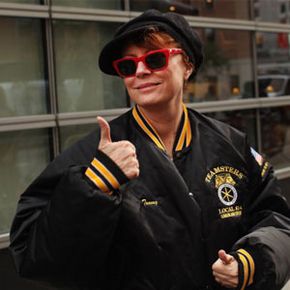 “Although they aren’t part of the 99 percent, Susan Sarandon and other celebrities support the Occupy cause.Spencer Platt/Getty Images
“Although they aren’t part of the 99 percent, Susan Sarandon and other celebrities support the Occupy cause.Spencer Platt/Getty Images
On Sept. 9, 2011, a Tumblr blog called "We Are the 99 Percent" went live, and people began sharing their stories of unemployment, staggering healthcare expenses, lack of access to quality educations and other grievances. The "99 percent" slogan refers to the imbalanced concentration of wealth in the United States among the richest 1 percent of the population. Just like the Adbusters post and Anonymous video that sparked online conversations about how, where and when to start a mass demonstration against economic power players, the Tumblr blog infused the political with the personal, providing human context for the protest.
But offline, who are the people who have shown up for the Occupy Wall Street movement?
Initially, the mainstream media painted Occupy Wall Street as a ragtag bunch of out-of-work college graduates, anarchists and aging hippies. Based on data gathered from OccupyWallSt.org, one of the most-visited Occupy-affiliated sites, the typical protester defies those initial stereotypes of an unemployed, over-educated mob. Rather, the average American Occupy activist appears to be a college-educated white male between 25 and 44 years old, who has a full-time job [source: Captain]. Additionally, Occupy Wall Street isn’t comprised of self-identifying Democrats. Seventy percent of those included in the October 2011 survey described their political views as independent [source: Captain].
In its early phases, the protest also attracted influential support — particularly that of labor unions. Occupy Wall Street’s demands for better jobs, wages and benefits for middle- and low-income America resonated within the employee advocacy groups that have historically battled and negotiated with businesses and corporations on behalf of their "99 percent" members. As of Nov. 1, 2011, some of the largest unions associated with Occupy Wall Street efforts around the United States include the following:
- AFL-CIO
- United Federation of Teachers
- Service Employees International Union
- New York City Transit Union
- Air Line Pilots Association
- Amalgamated Transit Union
- American Federation of State, County and Municipal Employees
Now that we know who, for the most part, makes Occupy Wall Street tick, how does this long-term protest movement work?
Celebrities Support Occupy Wall Street
On Sept. 19, two days after the initial Occupy Wall Street march, Roseanne Barr offered the first public celebrity endorsement of the protest movement. Since then, wealthy stars — some of whom may rank among that super-rich 1 percent — have stopped by Zuccotti Park to offer encouragement, including Kanye West, Alec Baldwin, Susan Sarandon, Russell Brand and Russell Simmons [source: Radar].
Occupy Wall Street Organization: Power to the People
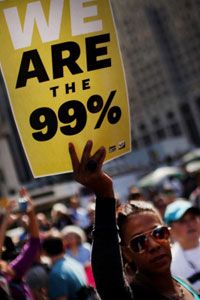 “Occupy Wall Street is a leaderless, populist-oriented movement.Spencer Platt/Getty Images
“Occupy Wall Street is a leaderless, populist-oriented movement.Spencer Platt/Getty Images
As a leaderless protest that’s focused on income inequality, the structure of Occupy Wall Street can be tricky to grasp, since no strict organizational hierarchy exists. Billed as a "people-powered movement" against the economic stakeholders responsible for wealth disparity, by November 2011, Occupy Wall Street consisted of general assemblies of protesters dotted around the world from New York, Chicago and Oakland to Brussels, Madrid and Athens [source: ABC News]. The size of occupations, ranging from clusters of activists in smaller towns and cities to the full-scale camps of hundreds exemplified by New York’s Zuccotti Park, determine the extent of each protest site’s needs. Those larger assemblies tend to have sub-committees that Occupy participants can join up with, which focus on specific needs, such as food, donation-gathering and sanitation.
The flagship New York Occupy Wall Street protest operates on "people’s assembly" principles enacted by Spanish activists known as indignados, which translates to "the outraged." On May 15, 2011, thousands of Spanish activists marched into Madrid’s Puerta del Sol square, where they demonstrated against the government’s failure to support its citizens by diverting the nation’s economic crisis and camped out, Zuccotti-style. The non-violent civil disobedience protesters relied on models of "collective thinking" in order to hash out their unified principles and platforms. In other words, the Spanish indignados debated and formulated their group-wide platforms through extensive discussion and consensus-building, rather than confrontation with law enforcement. The movement’s emphasis on non-violence echoes elements of other protests, such as the U.S. Civil Rights sit-ins of the 1960s and Mahatma Gandhi’s strategy of passive resistance.
The original New York Occupy Wall Street activists have followed in Madrid’s indignados‘ footsteps as they have hashed out their public demands, which we’ll delve into on the next page. For a tech-savvy, social media-connected movement, the nuts and bolts of Occupy consensus-building actually rely on some rudimentary — though some might say revolutionary — communication methods. For instance, since Zuccotti Park (and other Occupy Wall Street sites) prohibits microphones, bullhorns and other voice-amplifying devices, speeches to the collective of hundreds or even thousands rely on a technique called the "people’s microphone" [source: Hepler and Weigel]. The initial speakers, referred to as facilitators, deliver their addresses in clipped cadences that the crowd repeats to ensure everyone can hear.
Within the smaller working groups that focus on areas such as food and finance, the leaderless protesters also deliberate on dissenting perspectives and opinions and reach full agreement [source: Take the Square]. The Occupy activists then communicate their approval by "twinkling" their fingers above their heads [source: Hepler and Weigel].
What, in that case, has Occupy Wall Street twinkled in favor of so far?
Occupy Wall Street Principles: What does the 99 percent want?
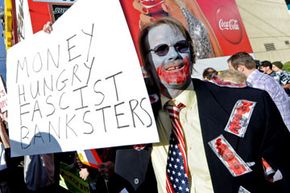 “Occupy Wall Street aims to bridge income disparity between the rich and poor.Ethan Miller/Getty Images
“Occupy Wall Street aims to bridge income disparity between the rich and poor.Ethan Miller/Getty Images
Following the initial Sept. 17, 2011, Occupy Wall Street rally, the media descended upon Zuccotti Park to figure out just what the renegades wanted. What they found — no official leaders or spokespeople, a hodgepodge of protest slogans on signs, a left-wing aesthetic — tended to elicit confusion rather than credibility. What, journalists continued to question, does the 99 percent want?
The Adbusters blog post inciting the Occupy movement demanded a Presidential commission on corporate malfeasance and a top-down severing of ties between Washington and Wall Street [source: Adbusters]. But like the roots of the global economic recession and widespread unemployment, the Occupy Wall Street platforms that emerged in the movement’s nascent days weren’t exactly cut-and-dried. On Sept. 29, 2011, the New York General Assembly in Zuccotti Park passed an official "Declaration of the Occupation of New York City" outlining the group’s grievances against the government and corporations, as well as their cornerstone rallying cry: "Exercise your right to peaceably assemble; occupy public space; create a process to address the problems we face, and generate solutions accessible to everyone" [source: OccupyWallStreet].
In that way, Occupy Wall Street functioned not only to arrest the attention of the people in power who, in protesters’ estimations, had faltered ethically, but also to engage the rest of the public affected by that questionable decision-making. Judging from Occupy Wall Street’s ripple effect, sprouting similar activist groups in more than 80 countries by mid-October 2011, it served as a stimulus for peaceful assembly as a visible, symbolic form of criticism against economic and corporate powers. The manifestations of those powers’ perceived faulty leadership — a depressed housing market, joblessness, international military operations — are manifold, but the method for protesting against them, as modeled by Occupy Wall Street, was intentionally simplistic and replicable in any location.
But with 14 million people unemployed in the United States in October 2011 and the global economic crisis stagnating, has Occupy Wall Street accomplished anything aside from mucking up a park in New York?
Occupy Social Media
Just like the "Arab Spring" public uprisings in Tunisia and Egypt, the actions and organization of Occupy Wall Street have taken shape and spread across social media sites, especially Twitter and Tumblr. For that reason, The Economist magazine refers to Occupy Wall Street as the "first true social-media uprising" in the West [source: Boudreau]. A pro-Occupy Web site, FeedtheProtest also accepts donations in a virtual currency called bitcoins. As of Oct. 3, 2011, the site had collected 70 bitcoins, or $350, in funding [source: Woolley].
Occupy Wall Street: Beyond Zuccotti Park
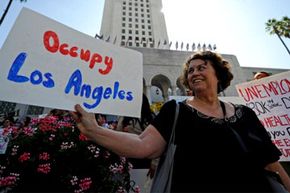 “The Occupy movement quickly spread to more than 900 cities.Kevin Djansezian/Getty Images
“The Occupy movement quickly spread to more than 900 cities.Kevin Djansezian/Getty Images
The first major milestone Occupy Wall Street accomplished was to fan the protest flames beyond the island of Manhattan. On Sept. 24, 2011, a small group started Occupy Chicago in Grant Park, although police peacefully arrested 130 protesters on Oct. 23, citing violation of a city ordinance [source: Rodriguez]. Run-ins with law enforcement like that have largely fueled publicity for the movement, inspiring others to occupy at local encampments in other cities and towns in displays of solidarity.
For instance, one early incident that supercharged the Occupy movement happened on Oct. 1, as thousands of demonstrators marched across the Brooklyn Bridge in New York. The police reportedly made more than 700 arrests, allegedly only removing people who were intentionally blocking thoroughfares [source: Chappell]. Perhaps influenced by the dramatic dedication to the Occupy cause displayed during that cross-borough march, less than a week later, copycat protests had sprung up around the nation, including ones in Boston, Memphis, Houston, San Francisco and Hawaii. On Oct. 18, activists at Zuccotti Park celebrated the one-month anniversary of the movement they helped start. By then, the protests — and their demands for government and corporate accountability — also had crossed international borders, with public space occupations both large and small in more than 951 cities in 82 countries, including the following:
- Spain
- Germany
- Belgium
- Lithuania
- The Netherlands
- New Zealand
- Brazil
- South Africa
- Australia
- Pakistan
- England
- Italy
- France
For the most part, the Occupy offshoots in the United States remained peaceable, with activists at some sites, such as Occupy Chicago and Occupy Atlanta, often volunteering to get arrested for symbolic reasons if an encampment violated local ordinances. Occupy Oakland, on the other hand, became one of the most controversy-stoking protest hubs, with law enforcement clashing more forcefully with protesters. On Oct. 26, Iraq War veteran and Occupy Oakland participant Scott Olsen was sent to the hospital in critical condition, after allegedly being struck in the head with a police projectile. When the incident occurred, Olsen had been demonstrating against Oakland police who were in the process of clearing out two occupy stations [source: Gabbatt].
Olsen’s injury only reinvigorated protesters, however, and Occupy Oakland launched a general city strike on Nov. 3, 2011. Thousands marched through the city and effectively shut down the Port of Oakland, the fifth-largest business port in the United States, for nearly 24 hours [source: Memmott].
Occupy Wall Street Costs
 “Breakfast in Zuccotti Park.Spencer Platt/Getty Images
“Breakfast in Zuccotti Park.Spencer Platt/Getty Images
Since the Occupy Wall Street movement is protesting the abuse of economic and corporate powers, it raises the inevitable question: How much does the movement cost? With police monitoring encampments, and public spaces being used as makeshift group homes, the protests undoubtedly come with their own price tags, depending on the size of each Occupy operation.
Within Zuccotti Park, the internal expenses of supporting a few hundred folks every day aren’t insignificant. Food alone runs between $2,000 and $3,000 daily, the bulk of which goes toward cheap staples such as peanut butter and fruit [source: Woolley]. Occupy Wall Street supporters have also donated plenty of food; nearby Liberatos Pizza, for instance, has sold about $6,000-worth of its specialty "OccuPie" pizzas purchased by donors [source: Woolley].
It’s also important to remember that Occupy Wall Street isn’t a homeless encampment. A majority of protesters in New York have full-time jobs, although they typically earn less than $25,000 per year [source: Captain]. Moreover, Occupy Wall Street isn’t running on a shoestring budget. In late October 2011, the movement announced that it had raised more than $500,000 in New York. The non-profit Alliance for Global Justice keeps track of New York City’s Occupy coffers, which receive an average 400 donations every day [source: Berkowitz]. In comparison, Occupy Chicago, one of the next-largest protest sites, reported about $20,000 in donations. The Occupy movement hasn’t acquired its thousands in large lump sums; a majority of monetary donations value less than $50 each [source: Berkowitz].
In mid-October, Occupy Wall Street protesters were almost kicked out of Zuccotti Park to allow in a cleaning crew. At the last minute, after pressure from local New York officials and protesters, Mayor Michael Bloomberg agreed to allow the occupation to stay put as long as they keep the green space clean [source: Saul and Fox]. The Department of Sanitation picks up trash regularly from the park, but it’s up to the protest’s Sanitation Working Group to manage the rest of the effort [source: Gray].
Cities are also having to pony up to pay policemen overtime to guard encampment barricades, control crowds and clear out illegal occupations (such as protesters remaining inside a public park after hours without a permit). New York City has spent more than $3.2 million on Occupy Wall Street-related law enforcement overtime pay [source: Woolley].
That fiscal disturbance in an already cash-strapped city is just one of the criticisms that some have lobbed against the Occupy Wall Street Movement.
Occupy Wall Street vs. Tea Party
 “The Tea Party directly opposes Occupy Wall Street.Mark Wilson/Getty Images
“The Tea Party directly opposes Occupy Wall Street.Mark Wilson/Getty Images
Though Occupy Wall Street claims to represent the 99 percent of the American public who are economically disenfranchised compared to the wealthiest 1 percent, that same super majority doesn’t support the cause. Since its first march on Sept. 17, Occupy Wall Street has attracted as much — if not more — opposition as it has support. According to a November 2011 poll from Connecticut-based Quinnipiac University, more Americans view Occupy Wall Street unfavorably (39 percent) than favorably (30 percent); a third of those surveyed had yet to make up their minds [source: Good].
Ironically, the group that shares Occupy Wall Street’s potent disgruntlement with the federal government is also the source of the movement’s harshest criticism. In 2009, the grassroots conservative Tea Party organized marches and rallies in opposition to excessive government spending. Instead of dressing up as zombies in business suits like the Occupy activists, Tea Party supporters donned Revolutionary-era tricorne hats and breeches as they picketed for a balanced federal budget, lower taxes and other platforms. Initially cast off by the mainstream media as an insignificant fringe group, the Tea Party gradually garnered political influence, as exemplified by the Congressional Tea Party Caucus [source: Travis].
The Occupy Wall Street protesters officially claim no political affiliation, and a majority self-identify as independent voters, but they’re characterized as a left-wing, liberal conglomeration. And as the growing gap between the rich and poor in the United States has expanded, the American political landscape has become more polarized between conservatives and liberals. So, just as the Tea Party represented the uprising of extreme political conservatism, some consider Occupy Wall Street to be the other side of that coin, vocalizing the demands of extreme political liberalism [source: Good].
Occupying public spaces doesn’t sit well with some of the Republican- and Tea Party-affiliated electorate because they perceive it as little more than lazy whining. In early October 2011, conservative Erik Erickson started the Tumblr blog "We Are the 53 Percent," lambasting the "99 Percent" movement for demonstrating against Wall Street rather than pursuing employment [source: Khimm]. The "53 Percent" symbolizes the percentage of Americans who pay federal income tax, which subsidizes the unemployed; the "53 Percent" bloggers also assume that Occupy activists are jobless, and therefore benefiting indirectly from federal income taxes.
But the ultimate question for the Occupy Wall Street movement is whether it can have any long-term effect where economic power in the United States ultimately resides: Washington, D.C.
Can Occupy Wall Street Succeed?
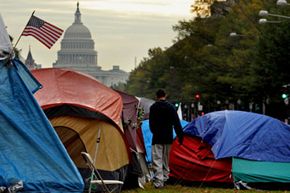 “Protesters occupy in the shadow of the U.S. Capitol.Chip Somodevilla/Getty Images
“Protesters occupy in the shadow of the U.S. Capitol.Chip Somodevilla/Getty Images
As Tea Party members and Occupy supporters duke it out in the blogosphere, the Washington, D.C. response to the movement has gradually become more accepting [source: Liasson]. While Republican Congress members don’t align with Occupy Wall Street, some conservative politicians acknowledge that income inequality in the United States is a valid issue that demands government attention. In a nod to the Occupy movement, Rep. Bruce Braley (D-Iowa) introduced the Targeted Wall Street Trading Tax bill in Congress in early November 2011; if passed, it would impose a tax on certain risky mortgage-market-related investments, such as credit default swaps [source: McAuliff and Rosenthal].
But in the long run, how much do Occupy Wall Street mentions in Congressional and presidential press conferences matter? Unlike the Tunisian and Egyptian protests focused on booting dictatorial rulers from power (Presidents Zine al-Abidine Ben Ali and Hosni Mubarak, respectively), the Occupy Wall Street measure of success isn’t so apparent. Some activists think that preventing Barack Obama from winning re-election in 2012 would send the appropriate message to the government that it needs to bridge income disparities [source: Rutkoff]. Others support the original Occupy Wall Street Adbuster blog post’s call for a Presidential Commission to address corporate influence on the government [source: Adbusters]. More than a specific, actionable end goal, Occupy Wall Street seeks populist-oriented social change, which it has resisted articulating in terms that are too restrictive. For that reason, what success means for the movement is, in short, an ongoing, ever-evolving, conversation [source: NPR].
In a way, Occupy Wall Street already has succeeded in terms of inserting itself into the Washington dialogue and holding politicians accountable to their demands for rectifying income inequality. Whether the scattered encampments will spawn a mainstream populist movement that inspires legislative change to divorce federal government from Wall Street influence remains to be seen. In the meantime, some feel the protest could learn a lesson from the Tea Party. Polls indicate that the Tea Party’s popularity has declined over time, which means that the window of opportunity for influencing politics can be narrow, and if Occupy Wall Street fails to seize its moment, the potential power of the 99 Percent might twinkle out.
Lots More Information
Related Articles
- How Protests Work
- How Riot Control Works
- How Labor Unions Work
- How Freegans Work
- How Recessions Work
- Top 10 Countries in the Red
- Which economic bubble will be next to burst?
- How Barack Obama Works
- Quiz: Getting to Know Barack Obama
- Dollars and Sense: Recession Quiz
Sources
- ABC News. "Occupy Wall Street Goes Global." (Nov. 4, 2011) http://abcnews.go.com/Business/slideshow/occupy-wall-street-global-14743854
- Adbusters. "#OccupyWallStreet." July 13, 2011. (Nov. 4, 2011) http://www.adbusters.org/blogs/adbusters-blog/occupywallstreet.html
- Berkowitz, Ben. "Occupy Wall Street finds money brings problems too." Reuters. Nov. 2, 2011. (Nov. 4, 2011) http://www.reuters.com/article/2011/11/02/us-usa-wallstreet-protests-money-idUSTRE7A12DY20111102
- Boudreau, John. "Occupy Wall Street, brought to you by social media." San Jose Mercury News. Updated Nov. 3, 2011. (Nov. 4, 2011) http://www.mercurynews.com/business/ci_19250002?source=rss
- Captain, Sean. "Infographic: Who Is Occupy Wall Street?" Fast Company. Nov. 2, 2011. (Nov. 4, 2011) http://www.fastcompany.com/1792056/occupy-wall-street-demographics-infographic
- Chappell, Bill. "Occupy Wall Street: From a Blog Post to a Movement." NPR. Oct. 20, 2011. (Nov. 4, 2011) http://www.npr.org/2011/10/20/141530025/occupy-wall-street-from-a-blog-post-to-a-movement
- Gray, Rosie. "At Occupy Wall Street, the Sanitation Crew Fights Cigarette Butts and Apathy." Village Voice. Oct. 19, 2011. (Nov. 4, 2011) http://blogs.villagevoice.com/runninscared/2011/10/at_occupy_wall.php
- Klein, Ezra. "Conservatives launch ‘We are the 53 percent’ to criticize 99 percenters." The Washington Post. Oct. 10, 2011. (Nov. 4, 2011) http://www.washingtonpost.com/blogs/ezra-klein/post/conservatives-launch-we-are-the-53-percent-to-criticize-99-percenters/2011/10/10/gIQA70omaL_blog.html
- Liasson, Mara. "Income Gap Becomes Politicians’ Latest Battleground. NPR. Nov. 4, 2011. (Nov. 4, 2011) http://www.npr.org/2011/11/04/142002704/income-gap-becomes-politicians-latest-battleground
- Matsu, Kono. "A Million Man March on Wall Street." Adbusters. Feb. 2, 2011. (Nov. 4, 2011) http://www.adbusters.org/blogs/adbusters-blog/million-man-march-wall-street.html
- McAuliff, Michael and Rosenthal, Max J. "Occupy Wall Street’s Message Gains Momentum." Huffington Post. Nov. 2, 2011. (Nov. 4, 2011) http://www.huffingtonpost.com/2011/11/02/occupy-wall-street-congress_n_1071745.html
- Memmott, Mark. "Occupy Oakland Strike Turns ‘Chaotic’." NPR. Nov. 3, 2011. (Nov. 4, 2011) http://www.npr.org/blogs/thetwo-way/2011/11/03/141970482/occupy-oakland-strike-turns-chaotic
- NPR. "Op-Ed: Occupy Wall Street Protestors’ Goals." Oct. 17, 2011. (Nov. 4, 2011) http://www.npr.org/2011/10/17/141427331/op-ed-occupy-wall-street-protesters-goals
- Occupy Wall Street. "Forum Post: First Official Release from Occupy Wall Street." Sept. 30, 2011. (Nov. 11, 2011) http://occupywallst.org/forum/first-official-release-from-occupy-wall-street/
- Radar. "10 Celebs Who Have Joined Occupy Wall Street." Oct. 21, 2011. (Nov. 4, 2011) http://www.radaronline.com/exclusives/2011/10/occupy-wall-street-celebrity-photos
- Rodriguez, Barbara. "Occupy Chicago: 130 Arrested in Grant Park Protest." Associated Press. Huffington Post. Oct. 23, 2011. (Nov. 4, 2011) http://www.huffingtonpost.com/2011/10/23/occupy-chicago-130-arrest_n_1027127.html
- Rutkoff, Aaron. "Who Is Occupying Wall Street? A Pollster Surveys the Protestors." Wall Street Journal. Oct. 19, 2011. (Nov. 4, 2011) http://blogs.wsj.com/metropolis/2011/10/19/who-is-occupying-wall-street-a-pollster-surveys-protester/
- Saul, Michael Howard and Fox, Alison. "Mayor: Political Pressure Forced Brookfield to Back Down." The Wall Street Journal. Oct. 14, 2011. (Nov. 4, 2011) http://blogs.wsj.com/metropolis/2011/10/14/mayor-political-pressure-forced-brookfield-to-back-down/
- Take the Square. "Quick guide on the group dynamics in people’s assemblies." July 31, 2011. (Nov. 4, 2011) http://takethesquare.net/2011/07/31/quick-guide-on-group-dynamics-in-peoples-assemblies/
- Travis, Shannon. "Who is the Tea Party Caucus?" CNN. July 29, 2011. (Nov. 4, 2011) http://politicalticker.blogs.cnn.com/2011/07/29/who-is-the-tea-party-caucus-in-the-house/
- Weigel, David and Hepler, Lauren. "Everything You Need to Know About Occupy Wall Street." Oct. 27, 2011. (Nov. 4, 2011) http://www.slate.com/articles/news_and_politics/politics/features/2011/occupy_wall_street/what_is_ows_a_complete_timeline.html
- Woolley, Suzanne. "Occupy Wall Street: The Price of Protest." Bloomberg. Oct. 18, 2011. (Nov. 4, 2011) http://www.bloomberg.com/money-gallery/2011-10-17/occupy-wall-street-the-price-of-protest.html#slide5


